Home / Piazzas of Florence
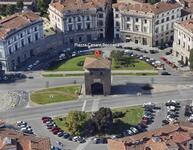 Piazza Cesare Beccaria is a square (more of a traffic circle really) located at the intersection of the Giovine Italia and Amendola boulevards. It was realized by the architect Giuseppe Poggi when Florence was the capital of Italy and was dedicated to Cesare Bonesana Marchese di Beccaria in 1876. Cesare Beccaria was an 18th-century Italian criminologist, jurist, philosopher, and politician. Beccar... read more.
Piazza Cesare Beccaria is a square (more of a traffic circle really) located at the intersection of the Giovine Italia and Amendola boulevards. It was realized by the architect Giuseppe Poggi when Florence was the capital of Italy and was dedicated to Cesare Bonesana Marchese di Beccaria in 1876. Cesare Beccaria was an 18th-century Italian criminologist, jurist, philosopher, and politician. Beccar... read more.
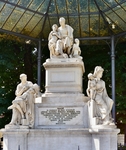 Piazza Demidoff: A Russian Noble in Florence
Piazza Demidoff (more like a small park) is dedicated to the family of the Russian ambassador Nicholas Demidoff, who lived in the nearby Palazzo Serristori, overlooking the square. Demidoff was a beloved figure in Florence for his generous philanthropy, and during his time in the city he funded numerous schools and assistance institutes, earning him a r... read more.
Piazza Demidoff: A Russian Noble in Florence
Piazza Demidoff (more like a small park) is dedicated to the family of the Russian ambassador Nicholas Demidoff, who lived in the nearby Palazzo Serristori, overlooking the square. Demidoff was a beloved figure in Florence for his generous philanthropy, and during his time in the city he funded numerous schools and assistance institutes, earning him a r... read more.
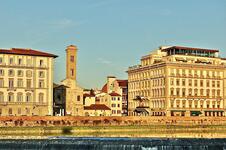 Situated on the northern side of the River Arno lies Piazza Ognissanti, an often overlooked but historically rich and vibrant square.
Historical Core
The heart of the Piazza is the Chiesa di Ognissanti (All Saints Church). This church, founded in the 13th century by the Benedectine Umiliati order, witnessed Baroque-style makeovers in the subsequent centuries. A treasure trove for art enthusiasts... read more.
Situated on the northern side of the River Arno lies Piazza Ognissanti, an often overlooked but historically rich and vibrant square.
Historical Core
The heart of the Piazza is the Chiesa di Ognissanti (All Saints Church). This church, founded in the 13th century by the Benedectine Umiliati order, witnessed Baroque-style makeovers in the subsequent centuries. A treasure trove for art enthusiasts... read more.
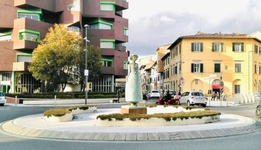 Piazza San Jacopino is a small piazza just west of the historic center of Florence. It features a traffic circle and a contemporary sculpture.
The piazza's name comes from the church of St. James, which is dedicated to the nearby church of San Jacopo in Polverosa. The church was named San Jacopino to distinguish it from other churches in Florence. The church once stood in the square but was demol... read more.
Piazza San Jacopino is a small piazza just west of the historic center of Florence. It features a traffic circle and a contemporary sculpture.
The piazza's name comes from the church of St. James, which is dedicated to the nearby church of San Jacopo in Polverosa. The church was named San Jacopino to distinguish it from other churches in Florence. The church once stood in the square but was demol... read more.
Piazza San Marco was built in the first half of the 15th century when Cosimo the Elder commissioned Michelozzo to build a church and a monastery for Dominican monks from the convent of San Domenico in Fiesole (today the monastery is in large part the Museum of San Marco, most famously noted for the residence of the monk Girolamo Savonarola and the paintings of Fra Angelico among others). The churc... read more.
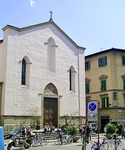 Piazza Sant'Ambrogio is overlooked by the church of Sant'Ambrogio (in English St. Ambrose), one of the oldest churches in Florence.
The building was the home of the Benedictines starting in the 10th century but remodeled at the end of the 13th century and restored several times during the following centuries. It is furnished with notable paintings and frescoes, among them the "Madonna del Latte"... read more.
Piazza Sant'Ambrogio is overlooked by the church of Sant'Ambrogio (in English St. Ambrose), one of the oldest churches in Florence.
The building was the home of the Benedictines starting in the 10th century but remodeled at the end of the 13th century and restored several times during the following centuries. It is furnished with notable paintings and frescoes, among them the "Madonna del Latte"... read more.
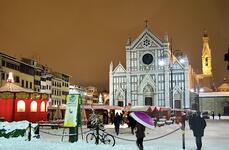 Piazza Santa Croce is one of the largest and most famous squares of central Florence. The Basilica of Santa Croce, the largest Franciscan church in the world, overlooks the piazza. The basilica's most notable features are its sixteen chapels, many of them decorated with frescoes by Giotto and his pupils, and its tombs and cenotaphs.
It is the burial place of some illustrious Italians, such as Mic... read more.
Piazza Santa Croce is one of the largest and most famous squares of central Florence. The Basilica of Santa Croce, the largest Franciscan church in the world, overlooks the piazza. The basilica's most notable features are its sixteen chapels, many of them decorated with frescoes by Giotto and his pupils, and its tombs and cenotaphs.
It is the burial place of some illustrious Italians, such as Mic... read more.
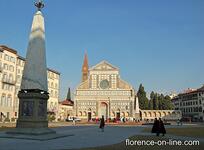 Piazza Santa Maria Novella was originally intended in the thirteenth century to hold the overflow of worshippers to the Santa Maria Novella church. Beginning in the late fourteenth century it was also used to hold the Palio dei Cocchi chariot races hosted by Cosimo I. The two obelisks were added in 1608 to serve as turning posts in the race. Across the piazza from the church is the fifteenth cent... read more.
Piazza Santa Maria Novella was originally intended in the thirteenth century to hold the overflow of worshippers to the Santa Maria Novella church. Beginning in the late fourteenth century it was also used to hold the Palio dei Cocchi chariot races hosted by Cosimo I. The two obelisks were added in 1608 to serve as turning posts in the race. Across the piazza from the church is the fifteenth cent... read more.
 Piazza Santa Trìnita is named after the Church of Santa Trìnita on the northwest side of the somewhat triangular square. Once an isolated area outside the original Roman city walls, the piazza became integrated into Florence's urban fabric in 1175 following the founding of the Vallombrosian church and convent of Santa Trìnita. The Vallombrosian order, a reformed Benedictine congregation founded in... read more.
Piazza Santa Trìnita is named after the Church of Santa Trìnita on the northwest side of the somewhat triangular square. Once an isolated area outside the original Roman city walls, the piazza became integrated into Florence's urban fabric in 1175 following the founding of the Vallombrosian church and convent of Santa Trìnita. The Vallombrosian order, a reformed Benedictine congregation founded in... read more.
In 1252, Augustinian monks built a monastery and a church dedicated to "Saint Mary of Ognissanti and the Holy Spirit", which became soon known as the Church of the "Holy Spirit", or as it is known today, Santo Spirito. In just a few decades the church became one of the most important in Florence, and at the end of the 13th century the City council bought the buildings in front of it and demolished... read more.
Piazza Savonarola is large rectangular square that was built in the 19th century. The piazza was dedicated to a Ferrarese friar and a statue for him was built in the square by Enrico Pazzi Ravenna, the same sculptor who built the statue of Dante in Piazza Santa Croce. He sculpted the statue in 1872 and until 1921 it was located in the Salone dei Cinquecento in Palazzo Vecchio before being transfe... read more.
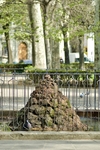 Constructed in 1865, this piazza takes its spatial inspiration from English gardens. Up until the First World War the garden was closed by a gate and only owners of the residences surrounding the square had keys to enter. The politician and writer Massimo d'Azeglio died a year before the city council decided to name the square after him in 1866.
The garden in the square is home to a number of pat... read more.
Constructed in 1865, this piazza takes its spatial inspiration from English gardens. Up until the First World War the garden was closed by a gate and only owners of the residences surrounding the square had keys to enter. The politician and writer Massimo d'Azeglio died a year before the city council decided to name the square after him in 1866.
The garden in the square is home to a number of pat... read more.
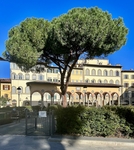 Piazza dei Ciompi, named for the "Ciompi" or wool carders of Florence (and their eponymous revolt in 1378), occupies a working class corner of Florence north of Piazza Santa Croce and close to Piazza Sant'Ambrogio.
It is a smaller, rectangular, neighborhood piazza which was finally renovated after after many years of planning by the city, complicated in part due to the existence of the mercatino ... read more.
Piazza dei Ciompi, named for the "Ciompi" or wool carders of Florence (and their eponymous revolt in 1378), occupies a working class corner of Florence north of Piazza Santa Croce and close to Piazza Sant'Ambrogio.
It is a smaller, rectangular, neighborhood piazza which was finally renovated after after many years of planning by the city, complicated in part due to the existence of the mercatino ... read more.
Piazza del Carmine is one of the main squares of the Oltrarno area of Florence and is dominated by the majestic Church of Santa Maria del Carmine. Today the piazza is cradled by the unfinished facade of the basilica, while to the south you can see the dome of the nearby Church of San Frediano in Cestello. Next to the Santa Maria del Carmine church door it is possible to visit the ancient monaster... read more.
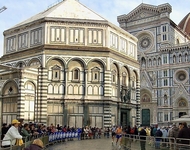 For the past 1600 years, the area known today as Piazza del Duomo has been one of the main points of Florence's religious life (in fact the medieval church of Santa Reparata lies buried beneath the pavement of the existing church). It is made up of the area in front of and around both sides and the rear of the Duomo, though many people also include Piazza San Giovanni (the area around the Baptistr... read more.
For the past 1600 years, the area known today as Piazza del Duomo has been one of the main points of Florence's religious life (in fact the medieval church of Santa Reparata lies buried beneath the pavement of the existing church). It is made up of the area in front of and around both sides and the rear of the Duomo, though many people also include Piazza San Giovanni (the area around the Baptistr... read more.
Piazza dell'Indipendenza is a large square in the heart of Florence's historical center. The square was built in the nineteenth century in order to celebrate the April 27, 1859 uprising that led to the abdication of Grand Duke Leopold II of Tuscany. The uprising was organized by patriots fighting for Italian unification.
The buildings facing the square were all constructed between the 19th and e... read more.
 Florence's Overlooked Historical Square
Florence is renowned for its iconic piazzas like Piazza della Signoria and Piazza del Duomo, but there is a square with profound historical significance hiding in plain sight: Piazza dell'Unità Italiana. This busy yet often overlooked piazza commemorates one of the most important chapters in Italian history -- the unification of Italy.
Historical Significa... read more.
Florence's Overlooked Historical Square
Florence is renowned for its iconic piazzas like Piazza della Signoria and Piazza del Duomo, but there is a square with profound historical significance hiding in plain sight: Piazza dell'Unità Italiana. This busy yet often overlooked piazza commemorates one of the most important chapters in Italian history -- the unification of Italy.
Historical Significa... read more.
Piazza della Libertà is the northernmost point of the historic centre of Florence. The piazza has been built and rebuilt many times up until the 19th century. After 1865, the square was demolished and finally rebuilt with a new design by Giuseppe Poggi. The square today is surrounded by a number of beautiful Florentine buildings. In the middle of the piazza lies a beautiful and peaceful garden w... read more.
Piazza della Repubblica is one of the largest and most famous city squares in Florence. It is the original site of the Roman Forum (from which columns are believed to be used in the interior of San Miniato). The remains of the ancient Campidoglio are buried beneath what once was the Teatro Gamberinus (now the location of the Hard Rock Cafà©!), just off the northwest corner of the piazza on Via Dà¨... read more.
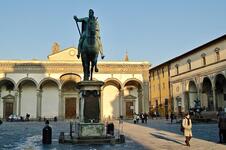 Arguably one of the most beautiful and harmonious squares in Florence, Piazza della Santissima Annunziata exemplifies the ideals of Renaissance architecture with works by some of the greatest artists and architects of the period. The piazza is surrounded on three sides by balanced porticoes, with the mostly southern oriented side opening on to Via dei Servi.
The area of the piazza was chosen in... read more.
Arguably one of the most beautiful and harmonious squares in Florence, Piazza della Santissima Annunziata exemplifies the ideals of Renaissance architecture with works by some of the greatest artists and architects of the period. The piazza is surrounded on three sides by balanced porticoes, with the mostly southern oriented side opening on to Via dei Servi.
The area of the piazza was chosen in... read more.
The Piazza della Signoria is the historic, artistic, political, and emotional heart of Florence. The most prominent feature of the Piazza (among many) is the Palazzo Vecchio, Florence's town hall, where the mayor still keeps his office. The current "L" shape of the Piazza is due to the razing of some medieval buildings during the Renaissance.
For much more detail and original photos check out ou... read more.
Piazzale Michelangelo is a famous square with a magnificent panoramic view of Florence. It was built in 1869 and designed by the architect Giuseppe Poggi during the urban renewal of the town. At the time, Florence was the capital of Italy and the middle class strongly wanted to show its rebirth.
The piazza is dedicated to the great Renaissance artist Michelangelo and is home to copies of some of... read more.
Piazzas of Florence
The piazzas of Florence are the centers of commerce, community, history, tourism and daily Florentine life. From the more touristy center of Piazza della Repubblica, to the smaller neighborhood piazzas like Piazza Ciompi, they all have a unique place in the history and life of the city.
You can navigate to our individual pages on each piazza using the map below:Piazzas of Florence Map
 Piazza Beccaria
Piazza Beccaria
 Piazza Cesare Beccaria is a square (more of a traffic circle really) located at the intersection of the Giovine Italia and Amendola boulevards. It was realized by the architect Giuseppe Poggi when Florence was the capital of Italy and was dedicated to Cesare Bonesana Marchese di Beccaria in 1876. Cesare Beccaria was an 18th-century Italian criminologist, jurist, philosopher, and politician. Beccar... read more.
Piazza Cesare Beccaria is a square (more of a traffic circle really) located at the intersection of the Giovine Italia and Amendola boulevards. It was realized by the architect Giuseppe Poggi when Florence was the capital of Italy and was dedicated to Cesare Bonesana Marchese di Beccaria in 1876. Cesare Beccaria was an 18th-century Italian criminologist, jurist, philosopher, and politician. Beccar... read more.  Piazza Demidoff
Piazza Demidoff
 Piazza Demidoff: A Russian Noble in Florence
Piazza Demidoff (more like a small park) is dedicated to the family of the Russian ambassador Nicholas Demidoff, who lived in the nearby Palazzo Serristori, overlooking the square. Demidoff was a beloved figure in Florence for his generous philanthropy, and during his time in the city he funded numerous schools and assistance institutes, earning him a r... read more.
Piazza Demidoff: A Russian Noble in Florence
Piazza Demidoff (more like a small park) is dedicated to the family of the Russian ambassador Nicholas Demidoff, who lived in the nearby Palazzo Serristori, overlooking the square. Demidoff was a beloved figure in Florence for his generous philanthropy, and during his time in the city he funded numerous schools and assistance institutes, earning him a r... read more.  Piazza Ognissanti
Piazza Ognissanti
 Situated on the northern side of the River Arno lies Piazza Ognissanti, an often overlooked but historically rich and vibrant square.
Historical Core
The heart of the Piazza is the Chiesa di Ognissanti (All Saints Church). This church, founded in the 13th century by the Benedectine Umiliati order, witnessed Baroque-style makeovers in the subsequent centuries. A treasure trove for art enthusiasts... read more.
Situated on the northern side of the River Arno lies Piazza Ognissanti, an often overlooked but historically rich and vibrant square.
Historical Core
The heart of the Piazza is the Chiesa di Ognissanti (All Saints Church). This church, founded in the 13th century by the Benedectine Umiliati order, witnessed Baroque-style makeovers in the subsequent centuries. A treasure trove for art enthusiasts... read more.  Piazza San Jacopino
Piazza San Jacopino
 Piazza San Jacopino is a small piazza just west of the historic center of Florence. It features a traffic circle and a contemporary sculpture.
The piazza's name comes from the church of St. James, which is dedicated to the nearby church of San Jacopo in Polverosa. The church was named San Jacopino to distinguish it from other churches in Florence. The church once stood in the square but was demol... read more.
Piazza San Jacopino is a small piazza just west of the historic center of Florence. It features a traffic circle and a contemporary sculpture.
The piazza's name comes from the church of St. James, which is dedicated to the nearby church of San Jacopo in Polverosa. The church was named San Jacopino to distinguish it from other churches in Florence. The church once stood in the square but was demol... read more.  Piazza San Marco
Piazza San Marco
Piazza San Marco was built in the first half of the 15th century when Cosimo the Elder commissioned Michelozzo to build a church and a monastery for Dominican monks from the convent of San Domenico in Fiesole (today the monastery is in large part the Museum of San Marco, most famously noted for the residence of the monk Girolamo Savonarola and the paintings of Fra Angelico among others). The churc... read more.  Piazza Sant'Ambrogio
Piazza Sant'Ambrogio
 Piazza Sant'Ambrogio is overlooked by the church of Sant'Ambrogio (in English St. Ambrose), one of the oldest churches in Florence.
The building was the home of the Benedictines starting in the 10th century but remodeled at the end of the 13th century and restored several times during the following centuries. It is furnished with notable paintings and frescoes, among them the "Madonna del Latte"... read more.
Piazza Sant'Ambrogio is overlooked by the church of Sant'Ambrogio (in English St. Ambrose), one of the oldest churches in Florence.
The building was the home of the Benedictines starting in the 10th century but remodeled at the end of the 13th century and restored several times during the following centuries. It is furnished with notable paintings and frescoes, among them the "Madonna del Latte"... read more.  Piazza Santa Croce
Piazza Santa Croce
 Piazza Santa Croce is one of the largest and most famous squares of central Florence. The Basilica of Santa Croce, the largest Franciscan church in the world, overlooks the piazza. The basilica's most notable features are its sixteen chapels, many of them decorated with frescoes by Giotto and his pupils, and its tombs and cenotaphs.
It is the burial place of some illustrious Italians, such as Mic... read more.
Piazza Santa Croce is one of the largest and most famous squares of central Florence. The Basilica of Santa Croce, the largest Franciscan church in the world, overlooks the piazza. The basilica's most notable features are its sixteen chapels, many of them decorated with frescoes by Giotto and his pupils, and its tombs and cenotaphs.
It is the burial place of some illustrious Italians, such as Mic... read more.  Piazza Santa Maria Novella
Piazza Santa Maria Novella
 Piazza Santa Maria Novella was originally intended in the thirteenth century to hold the overflow of worshippers to the Santa Maria Novella church. Beginning in the late fourteenth century it was also used to hold the Palio dei Cocchi chariot races hosted by Cosimo I. The two obelisks were added in 1608 to serve as turning posts in the race. Across the piazza from the church is the fifteenth cent... read more.
Piazza Santa Maria Novella was originally intended in the thirteenth century to hold the overflow of worshippers to the Santa Maria Novella church. Beginning in the late fourteenth century it was also used to hold the Palio dei Cocchi chariot races hosted by Cosimo I. The two obelisks were added in 1608 to serve as turning posts in the race. Across the piazza from the church is the fifteenth cent... read more.  Piazza Santa Trìnita
Piazza Santa Trìnita
 Piazza Santa Trìnita is named after the Church of Santa Trìnita on the northwest side of the somewhat triangular square. Once an isolated area outside the original Roman city walls, the piazza became integrated into Florence's urban fabric in 1175 following the founding of the Vallombrosian church and convent of Santa Trìnita. The Vallombrosian order, a reformed Benedictine congregation founded in... read more.
Piazza Santa Trìnita is named after the Church of Santa Trìnita on the northwest side of the somewhat triangular square. Once an isolated area outside the original Roman city walls, the piazza became integrated into Florence's urban fabric in 1175 following the founding of the Vallombrosian church and convent of Santa Trìnita. The Vallombrosian order, a reformed Benedictine congregation founded in... read more.  Piazza Santo Spirito
Piazza Santo Spirito
In 1252, Augustinian monks built a monastery and a church dedicated to "Saint Mary of Ognissanti and the Holy Spirit", which became soon known as the Church of the "Holy Spirit", or as it is known today, Santo Spirito. In just a few decades the church became one of the most important in Florence, and at the end of the 13th century the City council bought the buildings in front of it and demolished... read more.  Piazza Savonarola
Piazza Savonarola
Piazza Savonarola is large rectangular square that was built in the 19th century. The piazza was dedicated to a Ferrarese friar and a statue for him was built in the square by Enrico Pazzi Ravenna, the same sculptor who built the statue of Dante in Piazza Santa Croce. He sculpted the statue in 1872 and until 1921 it was located in the Salone dei Cinquecento in Palazzo Vecchio before being transfe... read more.  Piazza d'Azeglio
Piazza d'Azeglio
 Constructed in 1865, this piazza takes its spatial inspiration from English gardens. Up until the First World War the garden was closed by a gate and only owners of the residences surrounding the square had keys to enter. The politician and writer Massimo d'Azeglio died a year before the city council decided to name the square after him in 1866.
The garden in the square is home to a number of pat... read more.
Constructed in 1865, this piazza takes its spatial inspiration from English gardens. Up until the First World War the garden was closed by a gate and only owners of the residences surrounding the square had keys to enter. The politician and writer Massimo d'Azeglio died a year before the city council decided to name the square after him in 1866.
The garden in the square is home to a number of pat... read more.  Piazza dei Ciompi
Piazza dei Ciompi
 Piazza dei Ciompi, named for the "Ciompi" or wool carders of Florence (and their eponymous revolt in 1378), occupies a working class corner of Florence north of Piazza Santa Croce and close to Piazza Sant'Ambrogio.
It is a smaller, rectangular, neighborhood piazza which was finally renovated after after many years of planning by the city, complicated in part due to the existence of the mercatino ... read more.
Piazza dei Ciompi, named for the "Ciompi" or wool carders of Florence (and their eponymous revolt in 1378), occupies a working class corner of Florence north of Piazza Santa Croce and close to Piazza Sant'Ambrogio.
It is a smaller, rectangular, neighborhood piazza which was finally renovated after after many years of planning by the city, complicated in part due to the existence of the mercatino ... read more.  Piazza del Carmine
Piazza del Carmine
Piazza del Carmine is one of the main squares of the Oltrarno area of Florence and is dominated by the majestic Church of Santa Maria del Carmine. Today the piazza is cradled by the unfinished facade of the basilica, while to the south you can see the dome of the nearby Church of San Frediano in Cestello. Next to the Santa Maria del Carmine church door it is possible to visit the ancient monaster... read more.  Piazza del Duomo
Piazza del Duomo
 For the past 1600 years, the area known today as Piazza del Duomo has been one of the main points of Florence's religious life (in fact the medieval church of Santa Reparata lies buried beneath the pavement of the existing church). It is made up of the area in front of and around both sides and the rear of the Duomo, though many people also include Piazza San Giovanni (the area around the Baptistr... read more.
For the past 1600 years, the area known today as Piazza del Duomo has been one of the main points of Florence's religious life (in fact the medieval church of Santa Reparata lies buried beneath the pavement of the existing church). It is made up of the area in front of and around both sides and the rear of the Duomo, though many people also include Piazza San Giovanni (the area around the Baptistr... read more.  Piazza dell'Indipendenza
Piazza dell'Indipendenza
Piazza dell'Indipendenza is a large square in the heart of Florence's historical center. The square was built in the nineteenth century in order to celebrate the April 27, 1859 uprising that led to the abdication of Grand Duke Leopold II of Tuscany. The uprising was organized by patriots fighting for Italian unification.
The buildings facing the square were all constructed between the 19th and e... read more.  Piazza dell'Unità Italiana
Piazza dell'Unità Italiana
 Florence's Overlooked Historical Square
Florence is renowned for its iconic piazzas like Piazza della Signoria and Piazza del Duomo, but there is a square with profound historical significance hiding in plain sight: Piazza dell'Unità Italiana. This busy yet often overlooked piazza commemorates one of the most important chapters in Italian history -- the unification of Italy.
Historical Significa... read more.
Florence's Overlooked Historical Square
Florence is renowned for its iconic piazzas like Piazza della Signoria and Piazza del Duomo, but there is a square with profound historical significance hiding in plain sight: Piazza dell'Unità Italiana. This busy yet often overlooked piazza commemorates one of the most important chapters in Italian history -- the unification of Italy.
Historical Significa... read more.  Piazza della Libertà
Piazza della Libertà
Piazza della Libertà is the northernmost point of the historic centre of Florence. The piazza has been built and rebuilt many times up until the 19th century. After 1865, the square was demolished and finally rebuilt with a new design by Giuseppe Poggi. The square today is surrounded by a number of beautiful Florentine buildings. In the middle of the piazza lies a beautiful and peaceful garden w... read more.  Piazza della Repubblica
Piazza della Repubblica
Piazza della Repubblica is one of the largest and most famous city squares in Florence. It is the original site of the Roman Forum (from which columns are believed to be used in the interior of San Miniato). The remains of the ancient Campidoglio are buried beneath what once was the Teatro Gamberinus (now the location of the Hard Rock Cafà©!), just off the northwest corner of the piazza on Via Dà¨... read more.  Piazza della Santissima Annunziata
Piazza della Santissima Annunziata
 Arguably one of the most beautiful and harmonious squares in Florence, Piazza della Santissima Annunziata exemplifies the ideals of Renaissance architecture with works by some of the greatest artists and architects of the period. The piazza is surrounded on three sides by balanced porticoes, with the mostly southern oriented side opening on to Via dei Servi.
The area of the piazza was chosen in... read more.
Arguably one of the most beautiful and harmonious squares in Florence, Piazza della Santissima Annunziata exemplifies the ideals of Renaissance architecture with works by some of the greatest artists and architects of the period. The piazza is surrounded on three sides by balanced porticoes, with the mostly southern oriented side opening on to Via dei Servi.
The area of the piazza was chosen in... read more.  Piazza della Signoria
Piazza della Signoria
The Piazza della Signoria is the historic, artistic, political, and emotional heart of Florence. The most prominent feature of the Piazza (among many) is the Palazzo Vecchio, Florence's town hall, where the mayor still keeps his office. The current "L" shape of the Piazza is due to the razing of some medieval buildings during the Renaissance.
For much more detail and original photos check out ou... read more.  Piazzale Michelangelo
Piazzale Michelangelo
Piazzale Michelangelo is a famous square with a magnificent panoramic view of Florence. It was built in 1869 and designed by the architect Giuseppe Poggi during the urban renewal of the town. At the time, Florence was the capital of Italy and the middle class strongly wanted to show its rebirth.
The piazza is dedicated to the great Renaissance artist Michelangelo and is home to copies of some of... read more. Top experiences in and around Florence:
© 2005-2025 florence-on-line.com | About | Glossary | Newsletter | Site Map
Some links to external websites may be affiliate links (hotel bookings, guide books, activities, etc.). Using these services helps to support our efforts here with no additional costs to the user (you!).
Some links to external websites may be affiliate links (hotel bookings, guide books, activities, etc.). Using these services helps to support our efforts here with no additional costs to the user (you!).